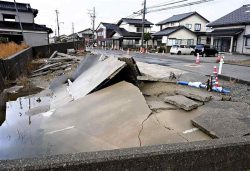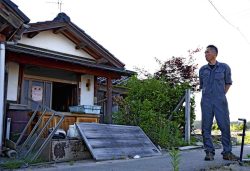20% of People in 6 Quake-Hit Municipalities in Ishikawa Prefecture Especially Vulnerable in Emergencies; Support Between People Faces Limit

Elderly people spend time at a shelter in Suzu, Ishikawa Prefecture, in January.
17:42 JST, March 4, 2024
More than 25,000 people in six Ishikawa Prefecture municipalities ravaged by the Noto Peninsula Earthquake require assistance when evacuating from a disaster, a survey by The Yomiuri Shimbun has found.
These include elderly or disabled people and find it difficult to evacuate by themselves in an event of an emergency. At 25,845, they account for 20.7%, or more than one in five, of the population in the area.
As many of the individuals who assist them are also growing old, there are voices in these municipalities saying there is a limit to how much they can support each other.
After the Great East Japan Earthquake in 2011, in which 60% of the victims were elderly people, the government strengthened measures for helping those vulnerable in time of a disaster. In 2013, the government mandated municipalities to have a registry of residents in need of special assistance in emergencies through an amendment to the Basic Law on Disaster Management. Since 2021, there are further efforts for municipalities to step up disaster preparation, with local governments being strongly advised to draw up an evacuation plan for each of these vulnerable residents, which includes an evacuation route for them and the name of the person who supports them.
The six municipalities in Ishikawa Prefecture are the cities of Wajima, Suzu, Nanao as well as the towns of Noto, Anamizu and Shika. Before the Jan. 1 quake, their local governments had completed an evacuation plan for just 2,617 people, or only 10% of those requiring support and lower than the national average of 14.3% as of January last year.
People aged 65 or older account for around 50% of the population in many of the municipalities in the prefecture’s Noto region, making it increasingly difficult for communities to support the elderly. In one district in Wajima, a single social worker is obliged to assist more than 10 different individuals.
“There are less people from younger generations, so the whole system no longer runs like before,” a person in charge lamented.
In Suzu, which was hit hard by the tsunami, the municipal government had designated supporters for each vulnerable person in the area long before the disaster. Even so, “Everyone was so busy with themselves the most we could do was talking to others in the neighborhood,” said a person involved with a voluntary disaster prevention organization.
The tsunami arrived in just 10 to 30 minutes after the quake in Suzu. In one district, the registry turned out very useful: “By using the list, we were able to quickly confirm the safety of each vulnerable person at shelters,” a person in charge said.
“When mutual assistance is needed, it’s useful to grasp the whereabouts of vulnerable people in the neighborhood at a community level and update the information [regularly],” said Toshitaka Katada, a project professor at the University of Tokyo specializing in disaster informatics. “The evacuation plan for each person is not bulletproof. Evacuating from a tsunami especially doesn’t give you time, so the ground rule is to be aware that you are responsible for your own life.”
"Society" POPULAR ARTICLE
-

M4.9 Earthquake Hits Tokyo, Neighboring Prefectures
-

Israeli Tourists Refused Accommodation at Hotel in Japan’s Nagano Pref., Prompting Protest by Israeli Embassy and Probe by Prefecture
-

M7.5 Earthquake Hits Northern Japan; Tsunami Waves Observed in Hokkaido, Aomori and Iwate Prefectures
-

Tsukiji Market Urges Tourists to Avoid Visiting in Year-End
-

M5.7 Earthquake Hits Japan’s Kumamoto Pref., Measuring Upper 5 Intensity, No Tsunami Expected
JN ACCESS RANKING
-

Keidanren Chairman Yoshinobu Tsutsui Visits Kashiwazaki-Kariwa Nuclear Power Plant; Inspects New Emergency Safety System
-

Imports of Rare Earths from China Facing Delays, May Be Caused by Deterioration of Japan-China Relations
-

University of Tokyo Professor Discusses Japanese Economic Security in Interview Ahead of Forum
-

Tokyo Economic Security Forum to Hold Inaugural Meeting Amid Tense Global Environment
-

Japan Pulls out of Vietnam Nuclear Project, Complicating Hanoi’s Power Plans























